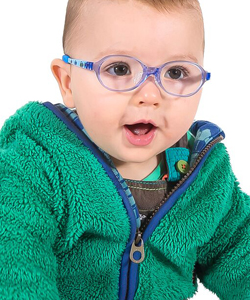Esotropia is a form of strabismus (crossed-eyes) that is caused by an inward turn of the eye, toward the nose.
The condition can be constant or intermittent and cause an individual to appear “cross-eyed”.
There are four different forms of esotropia:
- Congenital (infantile) esotropia
- Esotropia with amblyopia
- Accommodative esotropia
- Partially accommodative esotropia
Does your infant appear crossed-eyed?
Only 23 percent of infants are born with eyes that appear perfectly straight and aligned, so there is no need to panic if your newborn appears to have an eye turn!
Most infants are born with misaligned eyes, with one eye usually turning outward, appearing “crossed eyed”. Within the first three months of age, the eyes gradually straighten as they begin to develop the neural connections with the brain and work together as a coordinated team.
It is also common for infants to appear as if they have esotropia, because the bridge of the nose is not yet fully developed. As the bridge of the nose develops, more of the white of the eyes, the sclera, becomes visible on the nasal side, enabling the eyes to appear more aligned.
Congenital (infantile) esotropia
Infantile esotropia is a significant inward turn of one of the eyes during infancy, typically as a result of hyperopia (farsightedness).
This condition usually appears when the infant is between two and four months of age. A baby with infantile esotropia typically looks with one eye, while the other eye looks inward towards the nose, this is called cross fixation.
The primary concern with infantile esotropia is that the condition will inhibit the development of the two eyes to work together as a team— resulting in either reduced, or complete absence of binocular vision and depth perception.
Furthermore, poor eye coordination can lead to atypical gross motor development— preventing the infant to reach important developmental milestones.
According to the American Optometric Association (AOA), children who have had significant hyperopia during infancy are at a higher risk of developing strabismus and amblyopia (lazy eye) by the age of four. Moreover, the presence of anisometropic hyperopia, which is farsightedness with an unequal refractive error in both eyes, further increases the risk of the child developing strabismus and amblyopia.
How is infantile esotropia treated?
If the infant presents with a constant, significant inward eye turn, then surgery (which may include several procedures) may be required. However, the chance of developing binocular vision with surgery alone diminishes with age.
Therefore, even with multiple surgeries, an older child with infantile esotropia might appear as if his eyes are aligned, but normal binocular vision has likely not been achieved.
In this case, vision therapy to improve eye teaming, eye tracking, stereoscopic vision, and 3D depth perception should be provided.
In less severe cases, eye doctors may recommend prisms, eyeglasses, or occlusion (taping the inner third of eyeglass lenses) to reduce the tendency of the eye to turn inward. Additionally, vision therapy may be recommended to treat the underlying causes of the eye turn.
Schedule an exam with a vision therapy eye doctor and to start improving your child’s vision.
SEE RELATED: What Is Accommodative Esotropia?
Esotropia with amblyopia (lazy eye)
Children with strabismus and lazy eye must be identified and treated at a young age to increase their chances of restoring normal visual acuity.
Treatment for lazy eye typically involves eye patching of the stronger eye which forces the turned lazy eye to develop greater strength. Surgery (sometimes involving multiple procedures) may be recommended for a significant eye turn to re-align the eyes— though vision usually remains blurry even after surgeries. For this reason, vision therapy is typically prescribed to treat the visual pathways and reestablish the eye-brain connections.
Accommodative esotropia
Clear vision of close objects requires our eyes to converge (aim both eyes inward at the same time) in order to properly focus, or accommodate. Too much focusing power may lead to an inward turn of the eyes. If an inward eye turn is only noticed at around two years of age, it may be a result of poor integration of the accommodative system with the eye alignment (binocular) system.
Corrective lenses for treatment of accommodative esotropia
If the eye turn only occurs when focusing on close objects then wearing glasses for near vision may be effective at reducing or eliminating the esotropia.
In these cases, the eye turn is noticed when the child is playing with small objects, making eye contact, coloring, looking at picture books, and participating in other close vision tasks.
Additionally, if a child is significantly farsighted (hyperopia), an inward turn of the eye may even occur when focusing on distant objects, such as a television. In this case, corrective eyeglasses may be sufficient in treating the esotropia.
A bifocal or multi-focal corrective lens may be prescribed if the amount of inward turn is greater for closer objects than farther ones. When the eyes are aligned by corrective lenses they may spontaneously begin to work together. If this doesn’t occur, then a vision therapy program can help to improve visual skills and clear binocular vision.
Vision therapy for treatment of accommodative esotropia
Consistent eye turns cause the brain to actively ignore visual information coming from the affected eye (suppression), in order to prevent double vision. During vision therapy, your doctor may recommend occlusion of the stronger eye (using an eye patch) to retrain the brain and eliminate suppression.
Vision therapy is highly effective for the improvement of visual skills such as eye teaming, depth perception, and stereopsis— all necessary for clear binocular vision.
Esotropia that occurs intermittently does not usually require long term treatment. In this case, corrective eye wear may be recommended along with vision therapy, to improve ocular muscle coordination and eventually eliminate the bifocal.
Patients with accommodative esotropia should never undergo eye muscle surgery to eliminate the need for eyeglasses, as it can cause significant focusing problems with age.
Partially accommodative esotropia
In some instances, part of the inward turn is due to basic esotropia, while an additional amount is due to the effects of accommodation.
For partially accommodative esotropia, most eye doctors typically recommend eyeglasses (to reduce some of the eye turn) in addition to vision therapy (to retrain the visual centers of the brain).
Surgery can be another treatment option to address the non-accommodative portion of the esotropia. However, surgery alone rarely results in clear binocular vision. For this reason, vision therapy will most likely be recommended for full recovery of binocular vision.
Eyeglasses and vision therapy are the most effective treatments for esotropia.
LEARN MORE: Guide to Eye Turns
Schedule a comprehensive eye exam with your optometrist to obtain a proper diagnosis of esotropia and begin an appropriate treatment plan.










